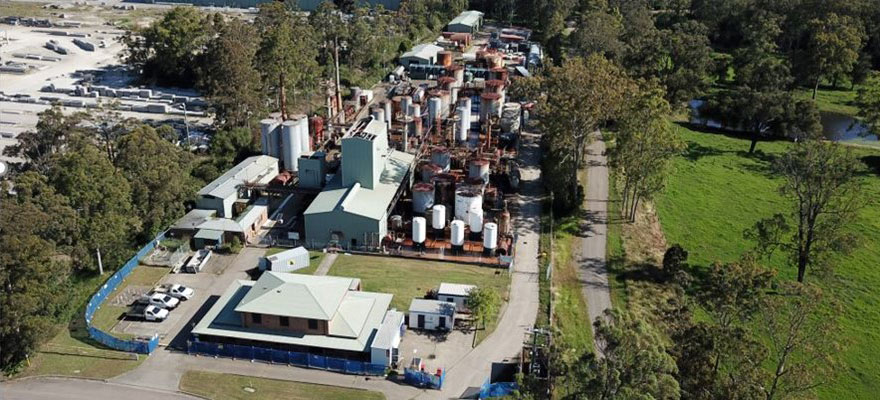
About the project
The NSW Government has stepped in to resolve the long-term environmental issues at the former Truegain waste oil processing site at Rutherford after compulsorily acquiring the land from its bankrupted former owner who failed to clean up the site.
Property and Development NSW’s (PDNSW) Environmental Management Group (EMG) is managing the clean-up of the property due to its expertise in remediating contaminated land.
EMG aims to ensure the soil and groundwater surrounding the site is clean and doesn’t pose any community or environmental risks.
Stage one remediation works, involving the removal of all above-ground infrastructure and the disposal of waste which had been stored on site, has been completed.
More than 11,000 tonnes of industrial wastewater, toxic oil, grease and sludge waste, as well as 135 steel containment tanks have been treated and removed from the site as part of the stage-one works.
EMG and the NSW Environment Protection Authority (NSW EPA) will continue to work together throughout the clean-up and remediation of the site to return it to a safe condition fit for its industrial zoning.
Background
Truegain operated a waste oil processing facility at the site from the late 1990s. In 2016, Hunter Water Corporation suspended Truegain’s trade waste permit and Truegain went into liquidation.
The site was abandoned, with many tanks and storage containers left on site containing large volumes of waste oil or processing by-products. Some included low concentrations of per- and poly-fluoroalkyl substances (PFAS).
The NSW EPA issued several penalty and clean-up notices in relation to the site and brought debt recovery proceedings against the former owner to recover the costs incurred in cleaning up the site. In December 2021 the former owner was ordered to pay $1.2 million towards the EPA’s costs.
When Truegain’s owner failed to comply with these notices, EMG was appointed to manage stormwater and remediate the site to prevent pollution.
Next steps
Investigations to determine the extent of soil contamination and surface water quality at the site and in nearby Stony Creek have started.
A detailed remediation action plan (RAP) for stage two of the works, which may involve soil and groundwater remediation, will be prepared once these investigations are completed.
Frequently asked questions
What are the pollution impacts?
The above-ground tanks, which have now been removed from the site, contained waste oil and wastewater, contaminated with mixtures of hydrocarbons and per- and poly-fluoroalkyl substances (PFAS).
PFAS are man-made chemicals widely used in industrial and consumer products, which take a long time to break down in humans and the environment.
Investigations into PFAS within the Rutherford Industrial Estate found PFAS in varying levels across the Estate, but this is not unexpected given the historic use of PFAS in a variety of industrial operations.
The NSW EPA undertook comprehensive testing for PFAS in the Estate, and in nearby creeks, after a containment system at the former Truegain premises overflowed into nearby Stony Creek in 2018. The results of this testing and further information can be found at the EPA website.
Does the pollution pose a threat to surrounding neighbours and the environment?
Protecting the community and the environment is the NSW Government’s highest priority.
The presence of PFAS on the Truegain site is a result of low concentrations present in waste oils and solvents. These wastes were held in tanks on site and, where spills occurred, they were on sealed or contained areas.
The NSW EPA had previously engaged a contractor to remove contaminated water from the site as needed to prevent the discharge of pollutants into the environment.
Throughout the remediation process the Government will continue to monitor, mitigate and manage the Truegain site, especially during rain events, ensuring the highest protections to the environment and the local community are maintained.
Why can’t the NSW EPA continue to manage pollution from the site?
The NSW EPA stepped in after the site was abandoned by its previous owner to manage and prevent stormwater and pollution escaping into the local waterways.
Now the property has been transferred to the NSW Government, the NSW EPA will continue to provide regulatory oversight to ensure remediation works meet the required standard and no further pollution occurs.
PDNSW’s Environmental Management Group is leading and managing the clean-up of the property due to its expertise in remediating contaminated land.
Why has it taken so long for the Government to intervene?
The Government will not remediate privately-owned land to benefit the polluter, so remediation work could not start until the site had been acquired.
This was delayed due to the site owners and stakeholders requesting compensation, which was in excess of the independent valuation for the property.
A compulsory acquisition process was undertaken and remediation works are well underway.
What will the site be used for once it is remediated?
The Rutherford industrial estate is at the centre of industry in Maitland, and our focus is on remediating this site to make it and the surrounding environment safe, create jobs and stimulate the local economy.
The site’s prime location has access to major transport and freight corridors, and there are opportunities to build on the industries already established here such as fabrication, distribution, and bulky goods.
Community updates
The waste has been removed from the site and the remediation and demolition of the above ground structures (tanks and buildings) has been completed.
Enviropacifc is currently investigating the underground site conditions, including soil and groundwater contamination.
The community will continue to be informed throughout the next stage of works.
Community notices:
- June 2022 (PDF, 778.37 KB)
- August 2022 (PDF, 316.04 KB)
- January 2023 (PDF, 274.91 KB)
More information
For further information email community_property@dpie.nsw.gov.au or call 1300 208 501